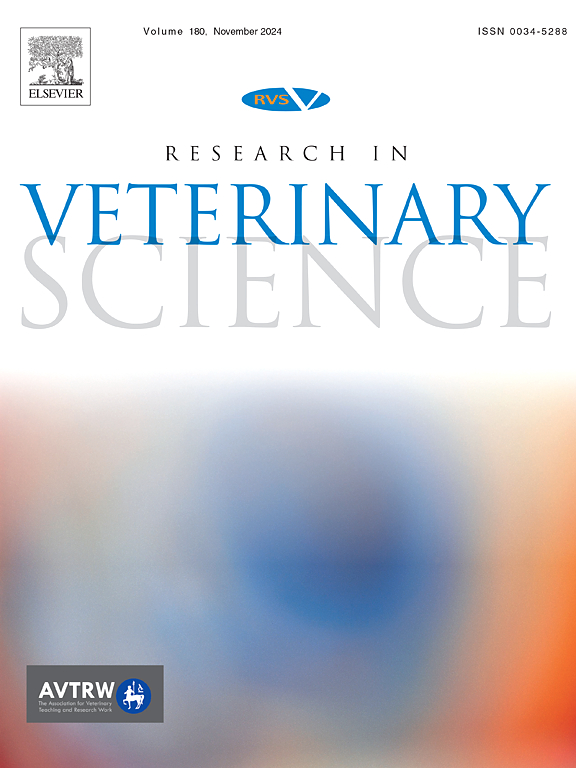处于不同 ACVIM 阶段的查理士王小猎犬的左心房容积和功能。
IF 2.2
3区 农林科学
Q1 VETERINARY SCIENCES
引用次数: 0
摘要
背景:正确评估左心房的大小和功能对于评估犬退行性二尖瓣疾病的严重程度至关重要:评估处于不同 ACVIM 阶段的查理士王小猎犬(CKCS)的左心房(LA)尺寸和功能,以及评估 LA 扩大的线性和容积指数的准确性:方法:多中心前瞻性横断面观察:多中心前瞻性横断面观察研究。犬只接受超声心动图检查,以进行品种筛选或心脏检查。比较不同等级的线性和容积超声心动图 LA 大小和功能指数:结果:犬只分配如下结果:犬只被分配如下:ACVIM A 级 43 只、ACVIM B1 级 58 只、ACVIM B2 级 55 只和 ACVIM C/D 级 42 只。在所有配对比较中,只有以体重为标准的 LA 前胸直径(LADn)和 LA 最大、最小和 P 容积(LAVmax、LAVmin、LAVP)存在差异。与 A 级相比,B1 级的主动 LA 排空分数(aLAEF)更高(P 结论和临床重要性):与 ACVIM A 级相比,ACVIM B1 级 CKCS 患者的 LADn 和 LAV 较高,这表明在疾病的早期阶段存在 LA 重塑。无症状犬的心房功能障碍明显。本文章由计算机程序翻译,如有差异,请以英文原文为准。
Left atrial volume and function in Cavalier King Charles spaniels at different ACVIM stages
Background
The correct assessment of left atrial size and function is essential to evaluate the severity of degenerative mitral valve disease in dogs.
Hypothesis/objectives
Evaluate left atrial (LA) dimension and function in Cavalier King Charles Spaniel (CKCS) at different ACVIM stages and the accuracy of linear and volumetric indexes to assess LA enlargement.
Animals
One hundred and ninety-eight privately owned CKCS.
Methods
Multicentric prospective observational cross-sectional study. Dogs underwent an echocardiographic exam for breed screening or cardiac examination. Linear and volumetric echocardiographic LA size and function indexes were compared between classes.
Results
Dogs were allocated as follows: 43 in class ACVIM A, 58 ACVIM B1, 55 ACVIM B2, and 42 ACVIM C/D. Only LA anteroposterior diameter normalized on body weight (LADn) and LA maximal, minimal and P volumes (LAVmax, LAVmin, LAVP) differed across all pairwise comparisons. Active LA emptying fraction (aLAEF) was higher in class B1 compared to class A (P < .001), and then decreased in class C/D compared to class B2 (P < .001). This suggests an increase in the left atrial active component due to the Frank-Starling mechanism in ACVIM B1 dogs, and the presence of atrial dysfunction in symptomatic dogs.
Conclusions and clinical importance
The LADn and LAV are higher in CKCS in class ACVIM B1 compared to class ACVIM A, suggesting the presence of LA remodelling at the early stages of the disease. Atrial dysfunction is evident in symptomatic dogs.
求助全文
通过发布文献求助,成功后即可免费获取论文全文。
去求助
来源期刊

Research in veterinary science
农林科学-兽医学
CiteScore
4.40
自引率
4.20%
发文量
312
审稿时长
75 days
期刊介绍:
Research in Veterinary Science is an International multi-disciplinary journal publishing original articles, reviews and short communications of a high scientific and ethical standard in all aspects of veterinary and biomedical research.
The primary aim of the journal is to inform veterinary and biomedical scientists of significant advances in veterinary and related research through prompt publication and dissemination. Secondly, the journal aims to provide a general multi-disciplinary forum for discussion and debate of news and issues concerning veterinary science. Thirdly, to promote the dissemination of knowledge to a broader range of professions, globally.
High quality papers on all species of animals are considered, particularly those considered to be of high scientific importance and originality, and with interdisciplinary interest. The journal encourages papers providing results that have clear implications for understanding disease pathogenesis and for the development of control measures or treatments, as well as those dealing with a comparative biomedical approach, which represents a substantial improvement to animal and human health.
Studies without a robust scientific hypothesis or that are preliminary, or of weak originality, as well as negative results, are not appropriate for the journal. Furthermore, observational approaches, case studies or field reports lacking an advancement in general knowledge do not fall within the scope of the journal.
 求助内容:
求助内容: 应助结果提醒方式:
应助结果提醒方式:


